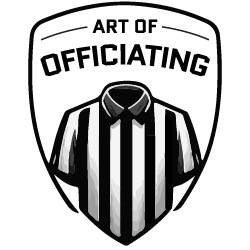Rules knowledge is like mastering a second language. When you’re immersed, hearing and speaking it every day, the words come naturally. When you step away, even for a short time, your vocabulary can slip. That’s true in the offseason, but it can happen just as quickly during the season.
Too many officials treat officiating as a Friday night activity. They dust off their stripes once a week, jog onto the field, and then put the game back on the shelf for the next 6 days. That’s not good enough. We can lose our edge even when we ignore officiating concepts for just a few days.
Fluency fades without use. Think about how languages work. If you only attend class one day a week and only open the textbook when you’re in class, you’ll never become fluent. Maybe you can squeak by and get a C grade in class. But if you are attending class to become proficient in the language, you’ve failed.
Football rules work the same way. If you only open the rules book when you’re working on the pre-season exam, or if you only open the book to look at a single rule during an association meeting, you will inevitably fail on the field.
Rules fluency is built during the week, not on Friday night.
I acknowledge that we all have lives beyond football. We have jobs, families, and commitments that rightly demand our time and attention. But we can’t afford to put football on the shelf for 6 days and only dust it off for two or three hours once a week. Or worse yet, we can’t afford to open the rules book once a year to pass a test. If we want to be sharp, we need daily exposure—even if it’s just 15 to 30 minutes.
That doesn’t mean studying until midnight every night. It means steady, purposeful touches that keep rules and mechanics fresh:
Read in short segments: Pick a single rule or case play and think it through. Could you explain it to a coach in real time?
Review film: Watch a handful of plays from your last game. If you primarily work subvarsity games or don’t have access to your game film, watch clips on YouTube. Look at formations. Determine your presnap and post-snap key(s). Evaluate the crews’ mechanics. Look for flags and decide if the foul calls were correct.
Talk it out: Communicate with a crewmate or mentor. When something goes wrong in a game, don’t just shrug and move on. Reconstruct the play and debrief it with someone else. That’s how you turn a mistake into growth. If you ignore it, the lesson is lost.
Quiz yourself: The Redding Study Guide is an excellent resource to study rules. Join a Facebook group or two. There are daily play discussions during the season.
Friday Night is the Test, Not the Study Session. When we step onto the field, that’s exam time. Coaches expect us to know the answers. Our crew depends on us to get it right. The time for study and discussion is Monday through Thursday. If we wait until Friday night to open the book, it’s like walking into a foreign country without practicing the language all week—we’ll be lost.
So here’s the challenge: commit to 15–30 minutes a day during the season. Read a page. Watch a clip. Answer a question. Have a conversation. Do something that keeps you connected. It’s not about perfection—it’s about fluency.
Bottom line: Rules knowledge is perishable, even in-season. If you only touch the game once a week, you’ll lose ground. But if you stay connected daily, even in small doses, you’ll walk onto the field prepared, confident, and fluent in the language of football.
Quiz
Read the quiz stem and then choose the best answer.
3/5 from the A-20. A23 is downed at the B-35. The referee signals “first down,” the umpire spots the ball on the B-35 and backs away, and the referee gives the silent wind to start the game clock. As the chain crew begins positioning the chains at the new spot, Team A’s coach curses the covering official for not throwing a flag for a late hit. The official throws a flag for unsportsmanlike conduct.
- 1/10 for Team A at midfield
- 1/25 for Team A at midfield
Review Rule 3-6-1b(2)
